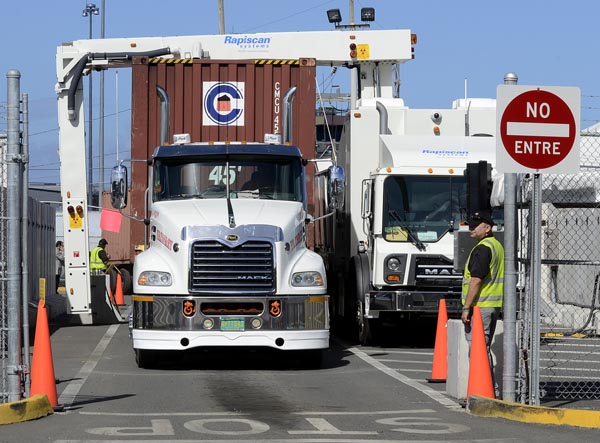Mandatory cargo inspections turn up drugs, no guns


As of April 2011, cargo containers arriving by sea must go through an electronic scanning system. (Credit: © Mauricio Pascual)
Nine months after the Puerto Rico Port Authority launched mandatory cargo inspections at the maritime facilities in San Juan, some 43,000 containers have been processed turning up “substantial drug shipments” but no illegal firearms, Gov. Luis Fortuño said Monday during a tour of the facilities.
So far, the only shipping company with an active scanning system in place is Crowley, which handles 20 percent of the cargo that arrives to San Juan.
When the controversial electronic scanning system was implemented in April 2011, government officials justified its $4.5 million investment and the associated inspection fee of up to $69 per container that would be passed on to shippers by saying that it was needed to curb contraband and illegal firearm and drug traffic.
While no arms have reportedly been found, the fact that drugs have been detected proves they have been entering the island through that channel, Fortuño said.
“This initiative seeks to ensure that Puerto Rico has a record of what enters the island through the containers,” Fortuño said. “For example, if it is informed that the container has a certain amount of oranges, is our business to verify that the contents are oranges, not oranges and shirts, or illegal weapons. That is what this project is about, looking for greater efficiency and security in our ports.”

So far, the only shipping company with an active scanning system in place since the requirement went into effect in April 2011 is Crowley, which handles 20 percent of the cargo that arrives to San Juan. (Credit: © Mauricio Pascual)
Inspection activity is expected to pick up this year, as more shippers adopt the scanning systems. Sea Star — which is responsible for processing 12 percent of the containers — is expected to complete the installation of the Rapiscan Systems technology later this month to open an additional big-rig inspection lane. Horizon and Intership, which handle 58 percent of the cargo containers, will follow suit during sometime in March or April, opening three more lanes.
Trailer Bridge and Luis Ayala Colón, which handle 8 percent of the maritime cargo shipments, will open another two lanes by summer.
The combined private investment exceeds $4 million, Fortuño said, who was accompanied during the tour of the facilities by U.S. Congressman John Mica, chairman of the Congressional Shipping and Infrastructure Committee, Port Authority Executive Director Bernardo Vázquez and Treasury Secretary Jesús Méndez.
Recently, the U.S. Department of Homeland Security allocated $1.9 million for the island’s container inspection initiative, Fortuño said.
“It is imperative that federal authorities assign greater resources and join in the Puerto Rico government’s efforts to expand the container inspections project to deter them from using them to transport and introduce illegal weapons and drugs to the island,” the governor said.
Justifying costs
During the news conference, Fortuño seemed to address the controversy that swirled around the inspection fees, which have been the target of criticism by different sectors — including the Puerto Rico Manufacturers Association and the Marketing, Industry and Food Distribution Chamber, known as MIDA — who claim they create a domino effect that impacts the costs of imported goods.
To that, Fortuño said inspection costs are $4 per ton, up to $69 per container. The average weight of a container is about 16 tons, which represents a fee of $64, which “translates into two-tenths of a cent per pound of product, or one cent for every five pounds.”
The cost, in addition to covering the scanning of containers and the collaborative efforts with U.S. Customs and Border Protection, covers more security guards, more cameras and improvements to the electronic surveillance system, additional lighting and security fencing at the San Juan maritime ports, he said.
Late last month, PRMA executives told News is my Business that the new security fee was one of three Fortuño administration-backed measures that significantly set back the island’s competitiveness last year by hindering free trade and industrial growth.
“This was basically a veiled tax. Six months after the pilot project was launched, we’ve seen that drugs and firearms are not coming in through the ports. If they were, it would have made front page headlines by now,” PRMA Deputy Executive Vice President Roberto Monserrate said. “It was a subterfuge to slap a $25 million charge on cargo entering the island in exchange for nothing.”














